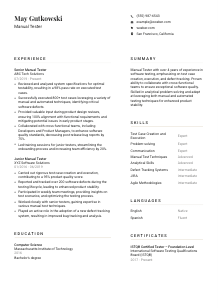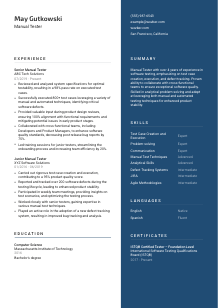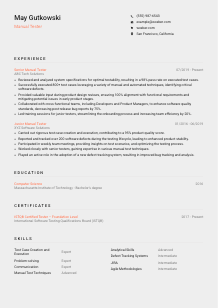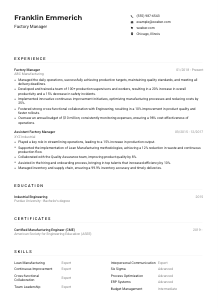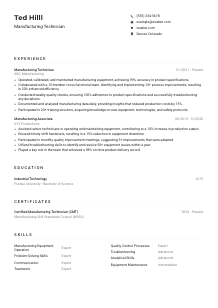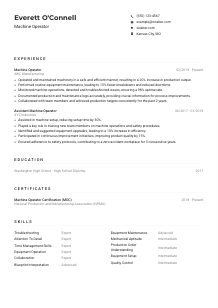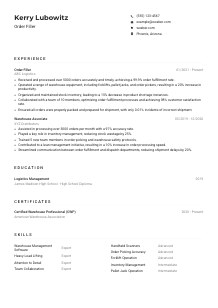Manual Tester CV Example
Hunting bugs, but your CV feels glitchy? Check out this Manual Tester CV example, debugged with Wozber free CV builder. Discover how to present your hands-on testing finesse to align with job demands, so your career journey remains as smooth as a passed test case!
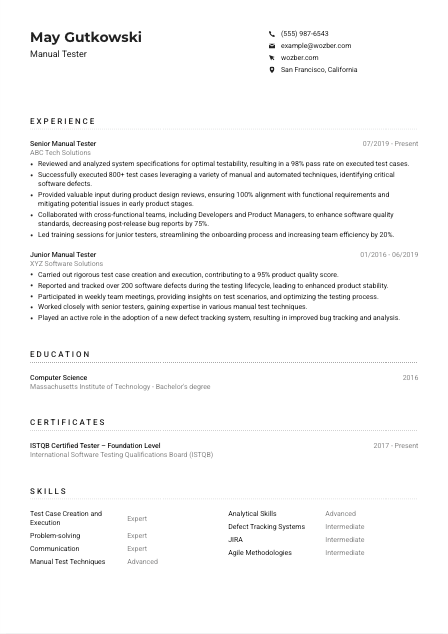
How to write a Manual Tester CV?
Hello there, aspiring Manual Tester! Stepping into the bug-hunting journey demands not only sharp skills but also a finely-tuned CV that sails smoothly through the realms of Applicant Tracking Systems (ATS) and captivates hiring managers. Using Wozber's free CV builder, this guide is your beacon through the art of sculpting a CV specifically for a Manual Tester role, making sure every line aligns with the job you're eyeing. Dive in as we dissect how to transform your CV into a testament to your expertise and a bridge to your next adventure in software testing.
Personal Details
Kicking off with Personal Details? Think of it as setting up your debugging environment before diving into the code. The goal here is crisp and clear: make it easy for hiring managers to see you're in the right location and easy to contact. Let's ensure your CV's header doesn't throw any exceptions.
1. Brand Yourself with Your Name
Think of your name as the function name of your career—make it noticeable. Opt for a font that's easy on the eyes but stands out from the rest of your document. This isn't just about aesthetics; it's about making your mark from the very beginning.
2. Sync with the Job Title
Immediately below your name, specify your targeted role - in this case, "Manual Tester." This isn't just for clarity; it's about SEO in the real world. You're otimizing your CV to be discovered for the right role. Plus, it signals to the hiring manager that your aspirations align perfectly with the job on offer.
3. Make Yourself Reachable
Include your phone number and a professional email address. A pro tip? Format your email as firstname.lastname@email.com. It's neat, and it avoids any confusion. Triple-check for typos—missing calls isn't something a Manual Tester can afford.
4. Geographical Alignment
The job wants you in San Francisco, California? Make sure your location matches. If you're open to relocating, it's still worth listing your current or targeted city. It's about setting expectations and showing you're in the loop.
5. A Professional URL
If you have a LinkedIn profile or a personal website showcasing your projects or certificates, include it. Just ensure it mirrors the professionalism and preciseness of your CV. It's your digital handshake, after all.
Takeaway
Wrapped up your Personal Details section? You're off to a great start. Think of this as laying down the groundwork for your CV's user interface. It's clean, it's functional, and it tells hiring managers: "Here's a Manual Tester who's not only skilled but also precisely aligned with what we're looking for." Move on with confidence; you're about to dive deeper into the realms of ATS optimisation and personal branding.





Experience
Now, let's turn our focus to the Experience section. This is where you get to show off your manual testing missions, speaking volumes about your bug hunting expertise. Each bullet point here should be like a successfully completed test case—proof that you're the pro they need.
- Reviewed and analyzed system specifications for optimal testability, resulting in a 98% pass rate on executed test cases.
- Successfully executed 800+ test cases leveraging a variety of manual and automated techniques, identifying critical software defects.
- Provided valuable input during product design reviews, ensuring 100% alignment with functional requirements and mitigating potential issues in early product stages.
- Collaborated with cross‑functional teams, including Developers and Product Managers, to enhance software quality standards, decreasing post‑release bug reports by 75%.
- Led training sessions for junior testers, streamlining the onboarding process and increasing team efficiency by 20%.
- Carried out rigorous test case creation and execution, contributing to a 95% product quality score.
- Reported and tracked over 200 software defects during the testing lifecycle, leading to enhanced product stability.
- Participated in weekly team meetings, providing insights on test scenarios, and otimizing the testing process.
- Worked closely with senior testers, gaining expertise in various manual test techniques.
- Played an active role in the adoption of a new defect tracking system, resulting in improved bug tracking and analysis.
1. Match the Requirements
Your first move? Align your roles and accomplishments with the job description. Did you review and analyze system specifications with a 98% pass rate? That's a headline. Make sure to break the job requirements down and mirror them in your experience. This isn't just tailoring; it's about showing you're already part of their world.
2. Layout Your Roles Clearly
Kick off with your most recent title and company, then work backward. This chronological layout not only showcases your growth but also helps hiring managers trace your journey in the realm of software testing without getting lost.
3. Detail Your Achievements
For each role, highlight your bug battles won and the peace you brought to codebases. Execute this with precision. Did you enhance software quality which decreased post-release bugs by 75%? That's epic. Use detailed statements that resonate with the job requirements, adding tech specifics where possible.
4. Quantify, Quantify, Quantify
Numbers are your best friend. They turn your experiences into measurable victories. Whether it's the number of test cases you executed or the percentage decrease in bugs post-release, adding numbers brings undeniable value to your achievements. It's data-driven proof.
5. Relevance Is Key
Your stint as a barista might have taught you a lot about stress management, but unless you can directly tie it to skills relevant to Manual Testing, leave it out. Focus on the roles and projects directly related to testing; each line should contribute to your narrative as a Manual Tester.
Takeaway
Nailed your Experience section? You've just built a compelling case showcasing why you're the ideal candidate for the role. Each of your roles tells a story of challenges, actions, and results—all framed within the specific demands of a Manual Tester. With this, you're not just applying; you're demonstrating your worth. Keep this momentum as you move onto the Education section, where the foundation of your testing prowess is laid out.
Education
The Education section serves as the backbone of your technical knowledge, reinforcing your qualifications. While it might seem straightforward, presenting it with a twist to match the Manual Tester role can make all the difference. Let's decode how.
1. Zero In On Key Requirements
First step? Align your education exactly with what the job asks for. A Bachelor's degree in Computer Science from 2016 is a perfect match here. This shows you're not just qualified; you've got the specific academic background they value.
2. Structure with Clarity
Maintain a clear hierarchy—degree, field of study, institution, and graduation year. This isn't just for aesthetics; it's about making it easy for hiring managers (and ATS) to verify your qualifications without a second thought.
3. Highlight Matching Qualifications
If your degree directly matches what the job description seeks (like our Bachelor's degree in Computer Science), you're golden. List it proudly, making sure it's impossible to miss. This is about showcasing you have the exact foundational knowledge required.
4. Consider Relevant Extras
While not always necessary, if you've taken specific courses or done projects that are highly relevant to manual testing, don't hesitate to mention them. This shows you've not just attended classes; you've actively sought knowledge that enhances your testing capabilities.
5. Other Achievements
Apart from your degree, if there are awards, honors, or extracurriculars that showcase skills or dedication relevant to the Manual Tester role, include them. This adds layers to your academic profile, indicating a well-rounded candidate.
Takeaway
With your Education section meticulously detailed, you've laid out the academic foundation of your skills as a Manual Tester. This section does more than tick a box; it reassures hiring managers that your expertise is built on solid ground. Next, illuminate your CV with Certificates—another beacon of your commitment and capability in the testing arena.
Certificates
In the ever-evolving world of software testing, Certificates are like badges of honor, showcasing your continuous learning and expertise. Highlighting them on your CV, especially ones as relevant as the ISTQB Certified Tester – Foundation Level, can significantly boost your application.
1. Align with Job Desirables
If the job listing mentions specific certificates like the ISTQB Certified Tester – Foundation Level, and you have it, you're in luck. Make sure it's among the first things hiring managers see in this section. It's about matching their checklist with your accolades.
2. Choose Quality Over Quantity
It's tempting to list every certificate, but focus on the ones most relevant to a Manual Tester. This shows you've invested time in honing skills that matter for the role you're eyeing. Each certificate should serve a purpose in building your profile.
3. Dates Matter
Include acquisition dates, especially for recent achievements. This signals to the employer your commitment to staying updated in the fast-paced world of technology. It's not just about having certifications; it's proving your knowledge is current.
4. Stay Proactive
Technology evolves, and so should you. Keep an eye on emerging trends and tools in manual testing, and consider adding certifications that keep you at the leading edge. This proactiveness is a quality every employer values.
Takeaway
Flaunting your certificates strategically can give you an edge in the application process. They are concrete proof of your expertise and readiness to dive into the Manual Tester role head-on. As you march forward to detailing your skills, remember, each certificate you mention is a testament to your dedication to excellence in the field of manual testing.
Skills
The Skills section of your CV is where you get to shine a spotlight on the tools and traits that make you a bug-hunting maestro. Here, it's about being precise and strategic, ensuring every skill listed aligns with what's highly valued in the world of manual testing.
1. Decode the Job Script
Begin by dissecting the job description for both explicit and implicit skills. Are proficiency in test case creation and a strong analytical skill set mentioned? Make sure they find their way into your skills list. It's like fine-tuning your CV to speak the language the ATS—and ultimately, the hiring manager—understands.
2. Highlight Essential Tools
Place premium skills and tools like manual test techniques, JIRA, and defect tracking systems front and center. This signals to hiring managers not just your familiarity but your proficiency with the essentials of manual testing.
3. Be Strategic
Resist the temptation to list every skill under the sun. Stick to the skills that the job requires and you excel in. This focused approach ensures your CV is not just ATS-compliant but also crafted with intention, clearly showcasing your qualification for the Manual Tester role.
Takeaway
Curating your skills with precision sets your CV apart in the sea of candidates. You've just given the hiring manager a clear picture of why you're not just a good fit but the perfect one for the Manual Tester position. With skills sharpened and aligned, let's move on to Languages—another facet of your diverse professional toolkit.
Languages
In a field as collaborative as software testing, communication is key, and mastering languages can be a significant asset. Reflecting your linguistic prowess, especially when English proficiency is a must, can subtly elevate your CV in the eyes of a global or diverse employer.
1. Verify Requirements
English language proficiency is a must for the role? Highlight your fluency level at the top. This directly addresses a key requirement, ensuring there's no room for doubt about your ability to efficiently communicate in the workplace.
2. Emphasize Key Languages
If the job or your work history involved specific language skills beyond English, list them, prioritizing relevance to the role. This underscores your versatility and potential to thrive in diverse teams or markets.
3. Clarify Your Proficiency
Use clear terms like ‘Native' or ‘Fluent' to describe your proficiency. This transparency ensures expectations are set right from the start, showcasing your candidature in an honest light.
4. List Additional Languages
Even if it's just conversational level, mention other languages you're familiar with. This can be a testament to your adaptability and eagerness to learn—traits highly valued in dynamic testing environments.
5. Assess Role Relevance
While not a primary focus for Manual Tester roles, showcasing your language skills could underscore your capability to engage in projects with a global or multicultural approach, adding another layer to your professional profile.
Takeaway
With your linguistic skills clearly outlined, your CV just got a boost in showcasing you as a well-rounded candidate ready to take on Manual Testing roles in diverse settings. Now, let's turn our focus to crafting a compelling Summary—a section that encapsulates your essence as a Manual Tester.
Summary
Your Summary is where you distill your professional essence into a few powerful lines. It's not just an introduction; it's your elevator pitch, making a compelling case for why you're the best candidate for the Manual Tester position even before the hiring manager dives deeper into your CV.
1. Capture Your Testing Spirit
Start by reflecting on your role and expertise in manual testing. Mention your experience duration and highlight your passion for digging deep into software to unearth bugs. This isn't about listing duties; it's about showcasing your dedication.
2. Directly Address Key Points
Weave in a mention of your proficiency in test case creation, execution, and collaboration with cross-functional teams. If you've excelled in areas directly mentioned in the job listing, such as reducing post-release bugs - highlight it here.
3. Keep It Tight
Aim for a 3-5 lines summary that packs a punch. This isn't the place for a deep dive; it's a snapshot, your headline article that entices the reader to want more. Make sure every word earns its spot.
4. Showcase Your Impact
End with a bang by stating the unique contributions you've made in previous roles. Was it enhancing software quality, streamlining processes, or mentoring juniors? Let your impact take the spotlight.
Takeaway
Crafting a refined Summary sets the tone of your CV, inviting hiring managers to explore further with intrigue. You've positioned yourself not just as a Manual Tester but as a noteworthy candidate whose profile demands attention. With every section now expertly tailored, you're equipped to use Wozber's free CV builder, including its ATS-friendly CV template and ATS CV scanner, to ensure your CV not only matches your ambitions but surpasses them. Ready to launch your application? Let your CV be the key that unlocks the door to your next Manual Tester adventure. The stage is set. The world awaits your expertise.
Embrace Your Manual Tester Journey
Congratulations on completing this tailored journey through CV crafting for the Manual Tester role. Armed with insights and Wozber's suite of tools designed for CV creation and ATS optimisation, you're now ready to step into the spotlight. Your CV isn't just a document; it's a narrative of your professional saga, designed to pique interest and provoke conversations. So, polish off your CV with Wozber's free CV builder, inject it with your unique professional essence, and step confidently towards your next manual testing challenge.
The path is clear, and the future bright. Happy bug hunting!

- Bachelor's degree in Computer Science, Information Systems, or a related field.
- Minimum of 3 years of experience in manual software testing.
- Proficiency in test case creation and execution, manual test techniques, and defect tracking systems.
- Strong analytical, problem-solving, and communication skills.
- Relevant certifications such as ISTQB Certified Tester – Foundation Level are a plus.
- English language proficiency is a must.
- Must be located in San Francisco, CA.
- Review and analyze system specifications for testability.
- Execute test cases (manual or automated) and analyze results.
- Participate in product design reviews to provide input on functional requirements and potential issues.
- Detect and document software defects and inconsistencies.
- Collaborate closely with cross-functional teams including Developers and Product Managers to ensure software meets quality standards.





